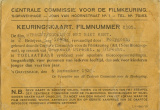The Cinema Question and School Cinema
On 8 January 1912, the Dutch newspaper ‘Nieuws van de Dag’ published a letter to the editor addressing cinema’s appropriateness – or lack thereof – for children. The author, a certain P., provided a summary of a number of scenes from films shown in Amsterdam which he deemed as unsuitable for children. Some of these were current affairs and news, others were staged recordings. P. had seen executions, people being branded, floggings, and so on. And all of this, in a city that had outlawed boxing matches as offensive.
In a brief editorial response, the ‘Nieuws van de Dag’ agreed with the author, writing that it expected the authorities to take appropriate action in the near future.
Unexpected meeting
There weren’t any measures taken immediately, but there was a response from another camp. In Utrecht in February 1912, social institutions and city councils had a meeting on the issue of school and cinema. In the end, the participants were persuaded that cinema could be useful for education. They decided to explore what it would cost to produce films for schools, and how best to show these to schoolchildren.
This was the beginning of a long series of discussions and pamphlets positing and defending every conceivable opinion – even a general ban on cinemas.
Ultimately, the discussion led to a number of cities implementing local film censorship boards. The task of carrying out the rating was handed over to local cinema commissions. This local rating system remained in effect until 1 March 1928, when the national film rating legislation, passed in 1926, became law.
New: programming for children
Before long, special film programmes for children were organised. The first plans for these date back to 1912. In 1918, The Hague was the first city to build a Gemeentelijke Schoolbioscoop (‘municipal school cinema’) which was supervised by schoolteacher (and later director of the Centrale Commissie voor de Filmkeuring), David van Staveren. A short time later, Rotterdam followed The Hague’s example; the local school cinema director there was A.J. van der Wel.
These school cinemas were well attended. The six different film programmes shown in The Hague in 1923 were seen by 80,000 people. Each programme ran for about six weeks, which meant that about 400 children attended per day.
Some of the titles shown that year included Het vogelleven op Mellum, Fjorden en gletschers, De vlieg en de mug and Röntgenstralen. Nearly all of these films can be found in the distribution catalogue from HAP & BenS, one of the Dutch distributors with a special department for educational films.
more information
If you are looking for more material from our collection, please contact Film Sales:
sales@eyefilm.nl
phone +31 (0)20 5891 426
